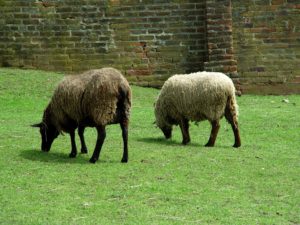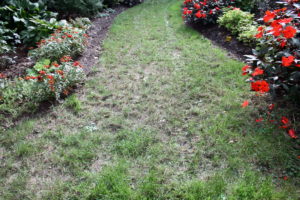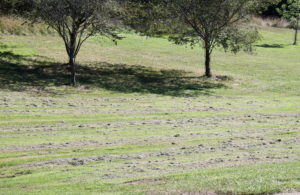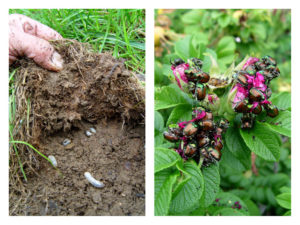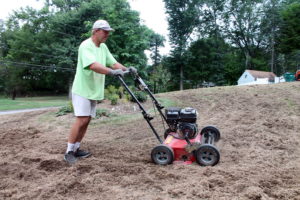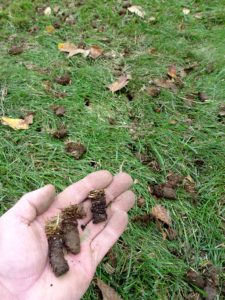How to Do Your Own Lawn Care
April 13th, 2021
The lawn-care pros who care for so many of our yards have no magic secrets on how to grow a nice lawn.
They just know what conditions and measures lawns need to thrive – and when and how to deliver them.
Any of us can do the same thing… if we learn a few basics and are willing to invest the time and effort.
DIY lawn care can save you hundreds of dollars a year. You’ll also get to decide how far you want to go, whether it’s a weed-free, thick, green carpet or just something better than dirt and weeds.
Here’s a pair of lawn-care game plans. One is if you’re the proud, would-be keeper of the perfect sward and one is if you’re satisfied with an OK lawn:
Crabgrass preventing
The first job of spring is determining your tolerance for crabgrass – that creeping, grass-like weed that elbows its way into the real grass with even the tiniest of openings.
This weed dies each fall but can sprout like crazy each spring from dropped and blown-in seeds.
Green-carpet way: Stop it before it gets started by using a lawn spreader to apply an annual granular crabgrass preventer, ideally when forsythia bushes are in peak bloom (usually late March to early April).
However, crabgrass can germinate beyond the eight-week window in which preventers typically work, so apply a second treatment in late May or early June if you have zero crabgrass tolerance.
Products with the ingredient dithiopyr kill crabgrass seedlings in addition to preventing sprouting, allowing it to be applied just once, four weeks later than other products.
OK way: Skip crabgrass preventers, and live with tolerable crabgrass outbreaks. Pull objectionable clumps in summer.
Think about crabgrass preventers only in springs after really bad infestations.
Fertilizing
Grass grew long before the Scotts Co. came along, so how much (or whether) you fertilize depends on how thick and green you want the lawn to be.
Green-carpet way: Test your soil every two to three years to get a report on nutrition and acidity levels. That’ll let you tailor products and amounts to your lawn’s needs. Otherwise, you’re just guessing.
Penn State University DIY soil-test kits are available for $9 or $10 at county Extension offices, many garden centers, and online at the Penn State soil test lab.
The standard application plan is four times a year: 1.) late March to early April; 2.) late May to early June; 3.) late August to early September, and 4.) between early and mid-November, before the ground freezes.
Lean toward long-acting organic fertilizers or chemical fertilizers that are high in slow-release nitrogen (the label indicates that); avoid products with phosphorus (unless your test specifically says you need it), and never fertilize when a lawn is browning from dry weather.
OK way: Do a soil test at least once to determine if you have any real out-of-whack situations worth addressing.
Skip fertilizing unless the lawn is thinning or performing too poorly for your liking.
Otherwise, start with a once-a-year fertilizer (use an organic product or a chemical one that’s high in slow-release nitrogen in late summer) and add a second application if that one alone isn’t suitable (late spring and late summer if you fertilize twice a year).
If twice a year still isn’t good enough, add a third one in November before the ground freezes.
Read more on fertilizing lawns at Penn State Extension
Liming
Lime is the main way to make acidic lawns more alkaline (as well as add calcium). Lawns perform best in near-neutral conditions (a pH of around 7).
Lime is not a regular need, though, as many believe. Your soil test will tell you if you need any lime at all, and if so, how much.
Green-carpet way: Use granular (not powdered or pulverized) lime and apply it in fall before the ground freezes. Early spring is another good time.
OK way: Ditto, but definitely only if a soil test says you need it and the lawn isn’t performing well.
Weed control
All sorts of annual and perennial weeds can invade thin lawns, many of which will outgrow grass.
The first defense is to encourage grass to grow as thickly as possible so there’s no space for weed seeds to germinate. (See “Seeding and overseeding” below.)
Green-carpet way: Kill new weeds by using a lawn spreader to apply a granular herbicide labeled for use in lawns. Ideal timing is May.
These kill weeds without harming grass, and different versions are available for broadleaf weeds (plantain, chickweed, dandelions, etc.) and grassy ones (foxtail, nimblewill, nutsedge, etc.)
Option: use a granular “weed-and-feed” product for your mid-May to mid-June treatment. This kills broad-leaf weeds and fertilizes at the same time.
To kill just a few weeds here and there (including throughout summer), spot-spray with a liquid herbicide labeled for use in lawns.
OK way: Control weeds as often (or as little) as you’d like between April and the end of October, using a liquid broad-leaf weed-killer that’s labeled for lawn use to spot-spray patches.
Resort to broadcast granular herbicides or “weed-and-feeds” only if/when creeping weeds are taking over the grass.
Bigger weeds can be dug out anytime with a hand weeding tool or screwdriver.
Read George’s column on 14 of our worst weeds
Seeding and overseeding
The two best times to start new grass or add more seed to thin areas (“overseeding”) is from Labor Day through the end of October and from end of March through April.
Keep seeded areas consistently damp until the seed germinates and is filling in.
Green-carpet way: Overseed every September/October with high-quality grass seed.
Read more on picking the best grass seed
For best sprouting, disturb the soil first by aerating, dethatching, or raking, or insert the seed directly into the ground by renting a slit-seeding machine.
OK way: Seed any areas that are thinning or bare each early spring and/or early fall.
If weeds are minimal and the lawn is doing reasonably well, skip it.
Read George’s column on how to fix a “ratty” lawn
Top-dressing
This is a way to improve poor soil and add organic nutrition by adding a light (quarter-inch) layer of sifted compost or similar, fine organic matter over the lawn surface.
Green-carpet way: Top-dress early each fall. It’s also a good way to lightly cover grass seed after overseeding.
OK way: Ditto, although you could skip it if the lawn is doing well enough already.
Note: Top-dressing can substitute for a late-summer to early-fall fertilizer treatment.
Watering
Lawns grow best with regular moisture in the top six inches of the soil.
However, they’re also very adaptable to dealing with dry spells, going brown and dormant for a month or more in a hot summer and then greening up when rain returns.
Green-carpet way: Use sprinklers or automatic irrigation systems to give lawns about one inch of water per week, split equally over three times a week. That should maintain good green growth all season.
Skip watering when rain does the deed for you, and scale back during cool, cloudy spells.
OK way: Don’t water. Tolerate any temporary mid-summer browning. The grass isn’t dead, just “resting” while growing conditions aren’t good.
Exception: if the lawn goes completely brown in a dry spell and stays that way for a month, apply a quarter of an inch of water per week… enough to keep the crowns from dying but not enough to trigger growth.
Read George’s column on why it’s not necessary to regularly water a lawn
Mowing
Cut high during the growing season (three inches is good), and mow often enough that you’re never removing more than one-third of the blades. Cut to two inches at the end of the season.
Let the clippings lie. Rake or bag only if they’re matting and threatening to shade out and kill grass.
Never mow wet grass or over wet ground.
Read George’s column on the right way to mow
Green-carpet way: In addition to the above, sharpen the blades every 25 hours. Alternate directions each cut.
OK way: Ditto is ideal, but sharpening once a year and mowing the same way each time won’t cause serious harm.
Bug and disease control
Chinch bugs and sod webworms are two common bugs that can damage lawns, while rust, brown patch, red thread, and dollar spot are some of our most common lawn diseases.
Read George’s column on 11 things that can go wrong in the lawn and how to fix them
Green-carpet way: Monitor regularly for early signs of trouble, determine exactly what’s causing the problem, then treat ASAP and accordingly with a product labeled for the diagnosed cause.
OK way: Monitor for trouble but treat only if the problem threatens to kill large sections of lawn. Even then, treat only if you’d rather do that than just reseed dead patches later.
Most bug and disease troubles are cosmetic and temporary, and lawns often bounce back and recover when weather conditions improve or when you correct underlying problems, such as lack of nutrition.
Grub preventing
Grubs are fat, white, curled, worm-like creatures that are the underground larval stage of beetles. They’re our most damaging lawn bug because they can kill large patches of grass by eating the roots out from under it, primarily from late summer into early fall.
Green-carpet way: Zero tolerance. Prevent them by using a lawn spreader to apply a granular grub preventer each year.
Products with chlorantraniliprole are best applied in May. Ones with imidacloprid are best applied in June.
If damage occurs anyway in August and September, apply a grub-killer (usually ones with trichlorfon or carbaryl).
OK way: Grubs aren’t equally bad every year. Take your chances and skip preventers, figuring on reseeding killed lawn patches in years when they do damage or applying a grub-killer if you notice unacceptable dying patches in late summer.
Organic alternative: apply microscopic grub-killing organisms called nematodes in late August or early September.
See George’s video on how to fix a grub-killed lawn
Dethatching
Decaying organic matter and dead surface grass roots make a “spongy” layer at the soil surface. A half-inch or less is harmless, but thicker buildups can inhibit rain penetration and a healthy exchange of oxygen, carbon dioxide, and other gases between the air and soil.
Over-fertilizing, pesticide use, and frequent, shallow irrigation can lead to excess thatch.
Green-carpet way: Late August through October is ideal for using a dethatching machine or stiff rake to rip out excess thatch. Compost it or use it as mulch (if you haven’t been using herbicides).
Then monitor every few years and repeat if unacceptable levels build up again.
OK way: No need to routinely dethatch. Do it only if you’re seeing poor lawn growth, and you find more than an inch of thatch buildup.
Better yet, correct the underlying causes.
Core aerating
This is a way to correct hard, compacted soil that’s making it tough for grass roots to spread and thrive. It involves using a machine with a rolling, spiked drum to remove cores of soil and deposit them on the surface.
Green-carpet way: Do it every early fall or two and follow up by spreading new grass seed, which will germinate in the openings.
OK way: Not necessary. Opinions differ on just how helpful core-aerating is anyway.








